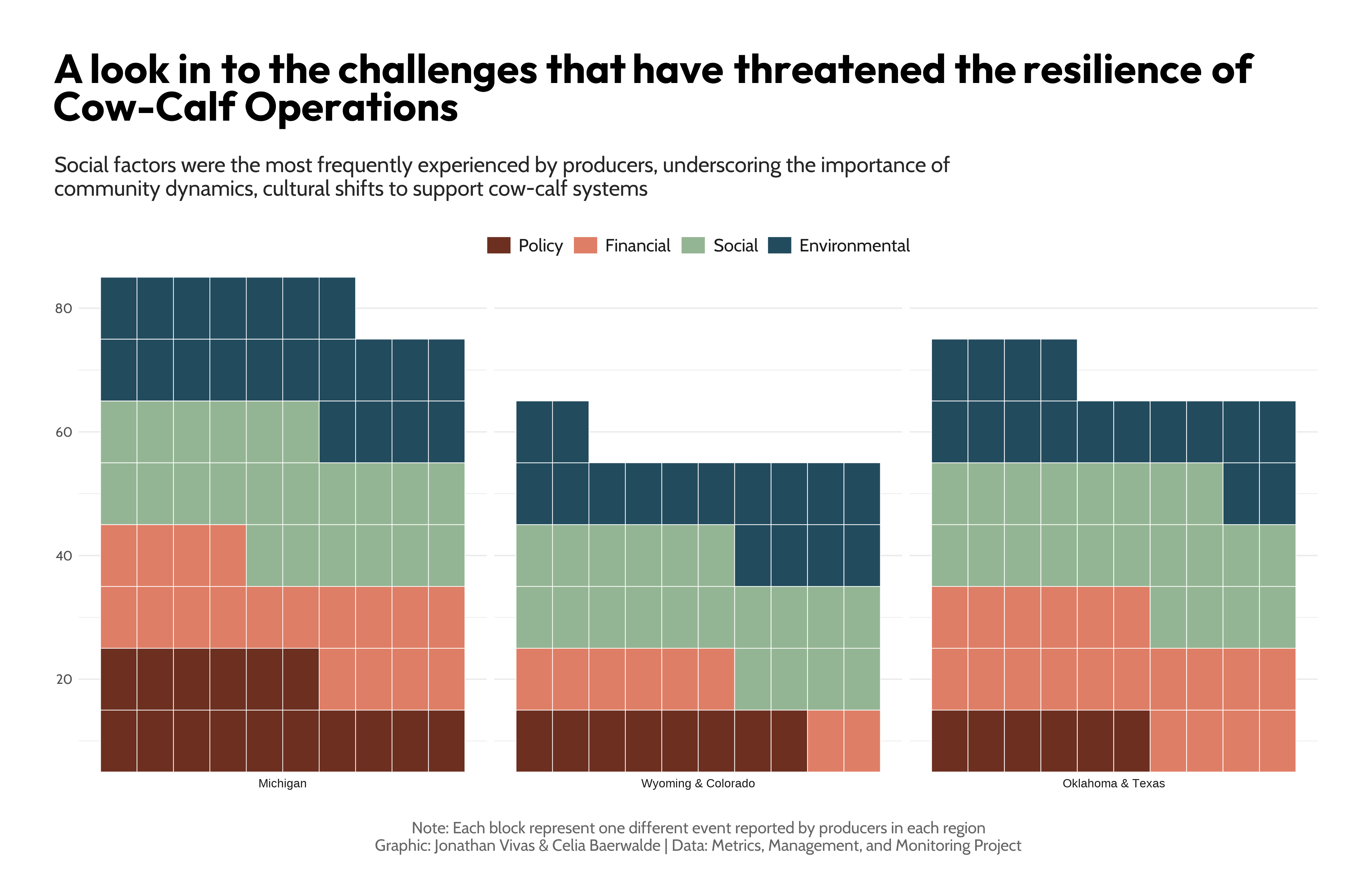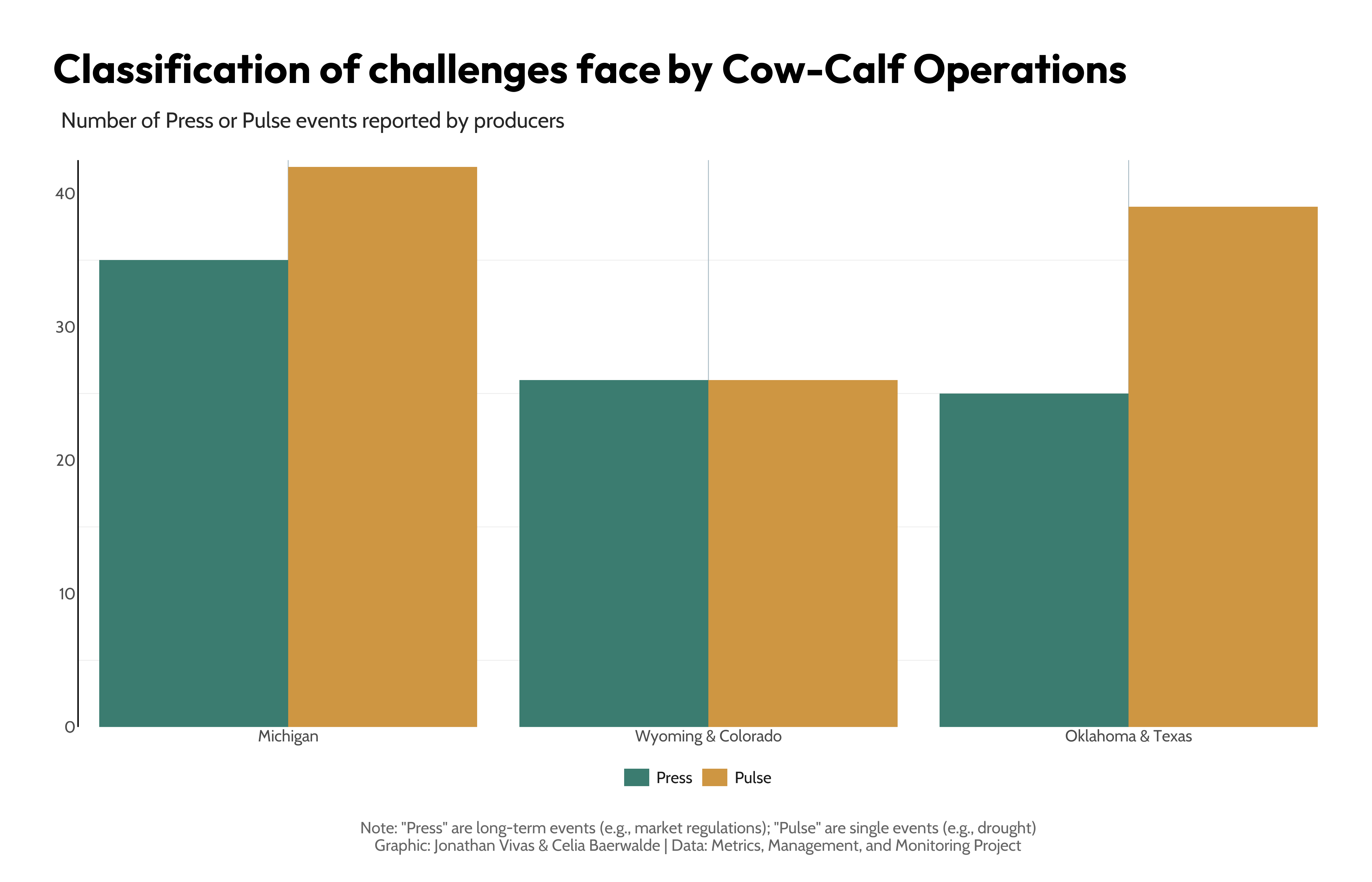Strengthening resilience: Understanding stressors in cow-calf production
Farmers’ recovery from past challenges offers insight into the resilience of cow-calf systems. This is the first in a series of articles where we describe the hardships cow-calf producers in three regions of the U.S. have adapted to.

Effective policymaking in agriculture depends on supporting systems that are not only profitable and environmentally sound but also promote the well-being of producers. For cow-calf operations, especially in rural areas where beef production anchors local economies, challenges like social isolation, financial instability and increasing climate extremes threaten both producer livelihood and community resilience.
Understanding the situations farmers and ranchers have adapted to and recovered from might offer valuable insights for strengthening the long-term viability of cow-calf systems and their resilience. With such a goal in mind, our social science team, as part of the Metrics, Management, and Monitoring (3M) project, are looking into the experiences of cow-calf operations across three distinct ecoregions: Michigan, Oklahoma/Texas and Wyoming/Colorado.
In 2023, the social science team of the 3M project carried out a participatory activity called World Café, following Jennifer Hodbod’s methodology, to gather details about producer experiences with stressor events and response strategies. These events were grouped into four categories. For instance, prices or market disruptions were labeled as financial. The clusters were also categorized as press if they were long-term processes (e.g., laws or regulations) or pulse if they were one-time events (e.g., fires, COVID-19). Producers collaboratively reconstructed the shocks they experienced in a timeline.
What we learned
The study revealed a certain level of variation in disturbances experienced by producers across regions. Social factors were the most frequently experienced (33.16% of total events), underscoring the importance of community dynamics, cultural shifts and societal perceptions. Environmental (27.46%) and financial (23.83%) factors also played major roles, while policy-related challenges (15.54%) were the least persistent. Of all events, 44.55% were categorized as press stressors (e.g., rising input costs) and were just slightly less frequent than sudden pulse events (e.g., droughts; 55.55%).

Regional differences shaped the types of challenges and suggested targeted resilience strategies (see Figure 2). In Michigan and Wyoming/Colorado social and environmental challenges were the two prominent categories. For instance, producers in Michigan reported bovine tuberculosis breakouts and farm succession challenges, while in Wyoming/Colorado urban encroachment and the challenges of ecotourism were commonly cited by producers. On the other hand, in Oklahoma/Texas we observed a strong focus on social and financial stressors, such as monopolies in processing and packing options, or the modern shift to technology and social media.
We differentiated between ongoing press stressors and sudden pulse events. In Michigan and Oklahoma/Texas pulse events were more common, for instance, more reports of wildfires, droughts. In Wyoming and Colorado producers reported an equal number of press and pulse events, for instance, the chronic threat of invasive species or the federal-level policies implementing land use restrictions for ranchers. This pattern suggests producers must navigate both chronic pressures and sudden disruptions. With these indicators, producers can be guided by common disruptions to understand where their approaches to adaptability could be focused.

Why does this matter?
Workshops provided rich, qualitative insights, helping producers identify key themes and connections to strengthen resilience. Notable concerns included soil health and ecological monitoring (Michigan), interconnected well-being (Wyoming/Colorado) and the effects of extreme weather and the need for data-driven decision-making (Oklahoma/Texas). These findings emphasize the central role of social networks in supporting producer resilience through shared knowledge, emotional support and collaborative learning.
The regional policy, climate and social differences have shaped the types of challenges and suggest various resilience strategies. Michigan showed an equal distribution across all factor types, calling for a holistic resilience approach. Wyoming/Colorado emphasized social and environmental challenges, indicating a need for strategies focused on community cohesion and ecological adaptation. Oklahoma/Texas reflected a strong focus on social and financial stressors, highlighting the importance of market access, financial stability and social support.
While the data reflects the views of voluntary participants and limits broad generalization, the producer-driven process highlighted valuable, region-specific resilience insights to inform future research, outreach, and policy efforts.
Further information and resources to support farmers are available through Michigan State University Extension.
Funding for this research was provided by the Foundation for Food and Agriculture Research (FFAR grant number: DSnew-0000000028), The Noble Research Institute, Greenacres Foundation, The Jones Family Foundation, and Butcherbox. The content of this publication is solely the responsibility of the authors and does not necessarily represent the official views of our funders.



 Print
Print Email
Email




